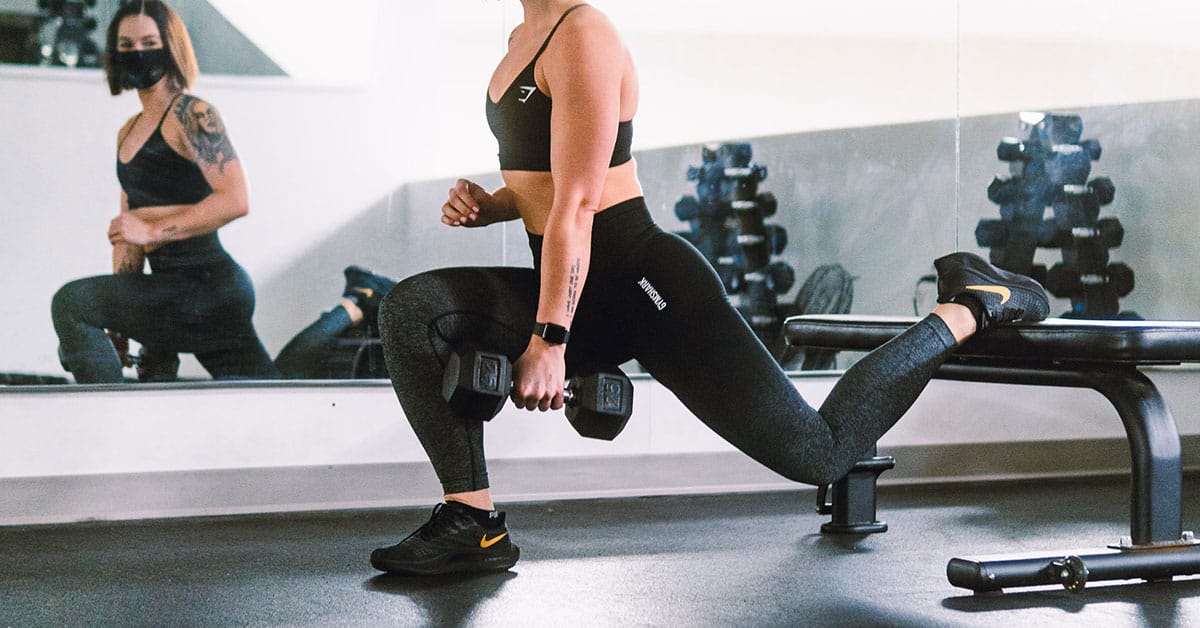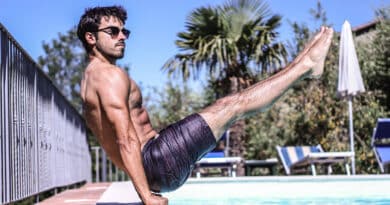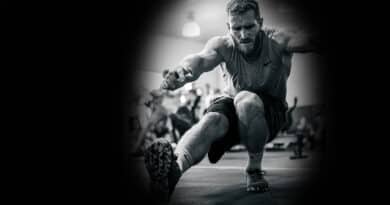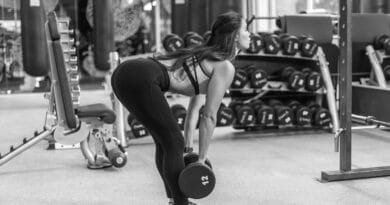The Best Bulgarian Split Squat Workouts and Technique Tips
The Bulgarian Split Squat is a highly effective lower body unilateral exercise that is versatile and useful for all athletes.
Bulgarian Split Squats Muscles Worked
The Bulgarian split squat is one of the best exercises you can do for developing your quads, hip flexors, and posterior chain (hamstrings, glutes, and back). It’s easy to learn, load, and program, and when it’s performed correctly, it’s also perfectly safe.
Benefits of the Bulgarian Split Squat
So, what benefits will the Bulgarian Split Squat bring for you?
Unilateral Benefits
Unlike the barbell squat, the Bulgarian split squat is a single-leg exercise, which can help prevent and correct muscle imbalances.
Many Variants
If you don’t like dumbbell Bulgarian Split Squats for whatever reason, you can always choose from one of a number of variations.
No Equipment Needed
Whether you’re on the road or in a fully stocked gym, one of the biggest benefits of the rear foot elevated split squat is that it doesn’t take a lot to feel a burn with this movement.
This makes it a great option to perform when traveling or in a spot with limited equipment availability.
Trains Multiple Muscles
As pointed out above, the rear foot elevated split squat is an awesome option for hitting multiple muscles at once.
The extension required during the concentric will improve quad and glute strength, and the eccentric loading will increase unilateral control and can help activate the hamstrings.
Decent Squat Alternative
Lacking a barbell? The rear foot elevated split squat has been suggested to provide comparable muscle activation to the back squat.
In a 2014 study, authors explored muscle activation and their differences in single-leg and double leg squat variations.
They suggested that the rear foot elevated split squat was comparable to the back squat with muscle activation and was an effective exercise for targeting the quads, hamstrings, tibialis anterior, and gluteus maximus.
Bulgarian Split Squat Form
Find a stable implement and place the front foot far enough way so the hips can sit into a single-leg squat position without the front foot coming off the ground.
Grip the floor with the front foot.
Slightly brace and sit into the hole thinking about bringing the hips straight up and down as if they’re on a string.
Keep the torso neutral or slightly leaned forward and allow the knee to track without allowing the heel to lift off the ground.
Drive through the front leg and press directly down into the ground contracting the quad.
Keep the hips inline and travel directly upwards while maintaining tension throughout the quad.
Check out these Mark Rippetoe Quotes
Extra Training Tips for the Bulgarian Split Squat
This exercise is intended to target your front leg—your back leg is there to offer some balance support, but the engagement and the “burn” should be felt primarily in your front leg, particularly the quadriceps of your front leg.
The main thing to remember about the Bulgarian split squat is that it takes some trial-and-error to find proper foot placement to perform the exercise comfortably.
You’ll place one of your feet on a bench behind you, but you may need to hop your front foot around a little bit to help you find the exact position that feels best.
History of the Bulgarian Split Squat
Well, no one knows exactly who created this exercise, but it was popularized by a Bulgarian Olympic weightlifting coach named Angel Spassov.
Olympic weightlifters live and die by the snatch and clean and jerk, which is why they’re always looking for more effective ways to develop lower body strength.
Spassov visited the U.S. in the 80s to share what he’d been up to on the other side of the Iron Curtain, and one of the exercises he was particularly enamored of was a single-leg squat. Word spread quickly, and soon after, Olympic lifters everywhere were doing Spassov’s “Bulgarian split squat.”
Ways to Get Better at the Bulgarian Split Squat
- Lift Heavy Weight
- Increase Your Grip Strength
- Use Straps
- Wear the Right Shoes
- Improve Your Hip Mobility
Build an iron-clad core with the Good Morning Exercise
Bulgarian Split Squat Workouts
Repetitions can be kept to the moderate repetition range (8-12) at light to moderate loads to allow for quality movement without high amounts of fatigues (which also leads to breakdowns in technique).
When used in warm-ups and/or muscle activation series, I prefer to use lighter loads for moderate to high repetitions to increase muscle temperatures and get the body working. All three of the situations do not entail a lifter loading with high amounts of loading or resistance and very little fatigue.
This ensures they are able to maximize muscular contractions and focus on the movement patterning.
Other techniques such as accommodating resistance, slow tempos, and other variations or split squats can all be placed here to increase performance and movement patterning.
WORKOUT 1
Main Lift: Bulgarian split squats – 5 sets of 5 reps each leg
Accessory: Squats – 3 sets of 8–12 reps
Finisher:
Bulgarian split squats – 1 set of 20 reps on each leg using half the weight you used in your main lift
WORKOUT 2
For Time
- Buy-In: 30 Tuck Jumps
20-10-8-6 reps of:
- Bulgarian Split Squats
- Back Squats
- Bicycle Crunch
Movement Standard
Bicycle Crunch: Lay with back flat on the ground. Place both hands behind the head and lift the upper torso, making sure the tension is not in the neck but in the abdominals.
Lift the left knee to meet the right elbow and the right knee to the left elbow just like pedaling a bicycle. This counts as one rep.
BULGARIAN SPLIT SQUAT HELLSET
Start with a pair of kettlebells held in a front rack, core tight, right leg set back on a bench, positioned for Bulgarian split squats.
Do 6 to 8 reps of pulse Bulgarian split squats, lowering into the bottom of the split squat, pausing momentarily, pulsing up so your thigh is just above parallel to the ground, then standing all the way up and squeezing your glutes.
Immediately transition into 6 to 8 reps of pause Bulgarian split squats, lowering into the bottom position, holding for one second with your back knee just off the ground, then standing all the way up and squeezing your glutes.
Immediately transition into 6 to 8 standard Bulgarian split squats.
Rest 45 to 60 seconds, then repeat on the other leg. Do 2 to 3 sets per leg.
Mechanical Drop Set
The mechanical drop set combines the deficit split squat with the regular split squat and then a partial range of motion split squat. Complete 6-8 reps from an elevated surface. Remove the surface and do 6-8 more reps. Lastly, complete 6-8 reps with partial range of motion.
Full Range of Motion, to Pulse, to Isohold
This routine manipulates range of motion. Complete 6-8 repetitions with full range of motion.
Then complete 6-8 pulse repetitions. Imagine the movement being broken down into four quadrants. Throughout the pulse you can pick the quadrants you want to be in.
You can pulse the bottom 50% of the exercise or the mid 50%. Be sure to keep your leg under constant tension.
The last part is an isohold. Hold your 90 degree position for 10 seconds.
Bulgarian Split Squat Mistakes to Avoid
Strides That Are Too Long
A stance that is too long can be limiting for quad activation due to the external load not being fully over the front leg. Also, if mobility is an issue, then a stance that is too long can limit quality range of motion.
Leaned Back Torso
The torso should have a slight forward lean to it. Leaning back can limit effectiveness of this exercise.
Forcing range of motion
New to this variation and can’t perform with proper depth without discomfort? Start with a lower elevated surface to place the back leg on. Don’t force the range of motion. Build it up gradually.
Bulgarian Split Squats FAQs
Check out the answers to these commonly asked questions about the Bulgarian Split Squat.
What are Bulgarian Split Squats Good For?
Bulgarian Split Squats are good for many things. As a lower body exercise, it strengthens the muscles of the legs, including the quads, hamstrings, glutes, and calves.
Although the Bulgarian split squat works many of the same muscles as a traditional squat, for some, it’s a preferred exercise
Why are Bulgarian Split Squats so Hard?
Bulgarian Split Squats are more difficult because you’re using almost your entire body weight on one leg instead of two. In addition, it requires more balance and you’re also having to stabilize the hip and knee joint in ways that aren’t required with two legged exercises.
Are Bulgarian Split Squats the same as Lunges?
The first major difference between these two movements is the way in which they are performed.
The lunge will be performed walking or with a step forwards, backwards, and sideways, while the split squat is static.
This makes the lunge slightly more dynamic and the split squat a more static movement.
Are Bulgarian Split Squats Bad for the Knees?
Let’s turn to Squat University…
“When performing a Bulgarian split squat when dealing with knee pain what’s better? A long stance or a narrower stance with the knee over the toe.
When rehabbing patients recovering from knee injuries like a torn ACL, patellar tracking or even patellar tendinopathy, I like to use a longer elevated split stance cuing for a more vertical shin position. When we look at the knee joint, the more forward the shin angle, the more compressive stress is placed on the knee joint and surrounding tendons– which early in the rehab process can increase symptoms.
For a healthy athlete without a current knee injury, a slightly narrower stance with the knee moving forward definitely can be an acceptable modification.
Transitioning to the slightly narrower stance can also be a good idea if the longer stance places excessive stress on your low back or hip flexors of your rear leg (due to a lack of hip extension mobility).
Regardless of what stance you take, make sure you work to keep your front foot completely glued to the ground the entire movement.
Keep the knee stable and don’t allow it to cave in. You can keep your rear foot planted toe down, or turn it flat (whichever feels most comfortable and stable).”
How much Weight Should you Use on Bulgarian Split Squats?
Once you have good technique, you can successfully add weight. Build this up slowly and youwill find the right weights and progression over time for you. I’ve seen people use 200 pounds external load on Bulgarian split squats, but not been able to squat 400 pounds.
Sure, the back leg helps handle a bit of the load, but you’re still squatting down on the front leg, giving it 80–95% of the load.
Bulgarian Split Squat Alternatives
If you like to mix things up, add these Bulgarian Split Squat alternatives into your training.
Back Barbell
This Bulgarian Split Squat simply swaps the dumbbells for the barbell.
Assisted Bulgarian Split Squat
The assisted Bulgarian Split Squat is more of a beginner exercise. But you can use it as a drop set as well. Hold onto something, maybe it is another chair, and complete your reps in a slow controlled fashion.
Creative routine: Rep out regular Split Squats for one minute on one leg. Once that minute is up, put your hand on something for assistance and rep out for another minute.
Side-Loaded Bulgarian Split Squat
In this variation we are simply changing where the load is.
Overhead Loaded Bulgarian Split Squat
In this variation we are simply changing where the load is.
Bulgarian Split Squat from Deficit
In this case we are increasing range of motion. If you do not have a box available, grab a big book to step on.
Bulgarian Jump Split Squat
The jump routine is more advanced. Don’t go for maximal height, go for control. Try to land in the same spot you took off from.
Bulgarian Deadlift to Squat
This routine combines the Deadlift and the Squat. Alternate between the two exercises for a total of 10 each (20 reps).
Muscles of the Legs
The Bulgarian split squat is one of the best exercises you can do for developing your quads, hip flexors, and posterior chain (hamstrings, glutes, and back). Let’s dive deeper into how these muscles function.
Quads
The quadriceps muscles, commonly called the “quads,” are powerful muscles involved in lower body movement and propulsion. The quadriceps muscles consist of four large muscles at the front of the thigh. These muscles are primarily responsible for hip flexion and extension at the knee joint.
Hip Flexors
Your hip flexors are a group of muscles near the top of your thighs that are key players in moving your lower body. They let you to walk, kick, bend, and swivel your hips. But if your muscles are too tight or if you make a sudden movement, your hip flexors can stretch or tear.
Hamstrings
In human anatomy, a hamstring (/ˈhæmstrɪŋ/) is any one of the three posterior thigh muscles in between the hip and the knee (from medial to lateral: semimembranosus, semitendinosus and biceps femoris). The hamstrings are quite susceptible to injury.
Glutes
The gluteal muscles, commonly called glutes are a group of three muscles which make up the buttocks: the gluteus maximus, gluteus medius and gluteus minimus. The three muscles originate from the ilium and sacrum and insert on the femur.
If you want to further strengthen and improve your legs, try these reverse lunge or back squat workouts.





Comments are closed.